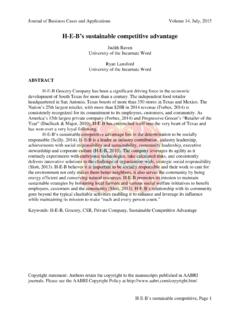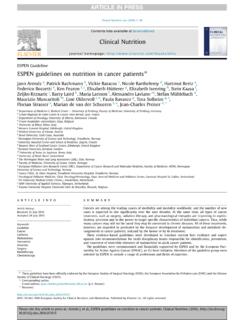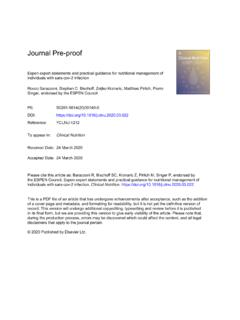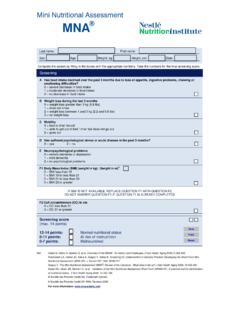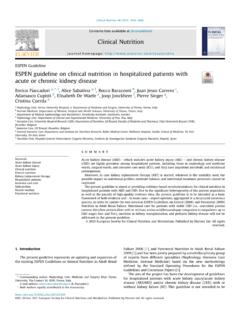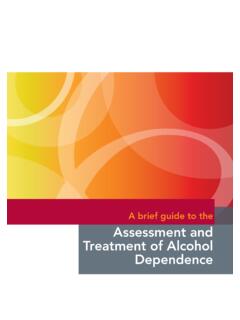Transcription of Action research: enhancing classroom practice and ...
1 Journal of Instructional Pedagogies Action research : enhancing classroom practices, Page1 Action research : enhancing classroom practice and fulfilling educational responsibilities Mark R. Young Winona State University Eve Rapp Winona State University James W. Murphy Winona State University Abstract Action research is an applied scholarly paradigm resulting in Action for continuous improvement in our teaching and learning techniques offering faculty immediate classroom payback and providing documentation of meeting our educational responsibilities as required by AACSB standards. This article reviews the iterative Action research process of planning, acting, observing, reflecting and revising in which faculty/researchers collaborate, openly communicate, critically analyze, reflect and relate their classroom practice to theory. An innovative experiential learning activity (Bake Sale) designed to teach marketing concepts to Principles of Marketing students is used to illustrate the Action research process.
2 Keywords: Action research , pedagogy, active learning, experiential learning Introduction to Action research Action research is an applied scholarly paradigm resulting in Action for a specific context offering faculty immediate payback by improving his or her own teaching and providing explicit documentation for meeting their educational responsibilities as required by AACSB standards. It seeks to document the context, change processes, resultant learning and theorizing of faculty in developing their pedagogies (Fisher and Phelps, 2006). John Elliott (1991) defines Action research as: Action research is the process through which teachers collaborate in evaluating their practice jointly; raise awareness of their personal theory; articulate a shared conception of values; try out new strategies to render the values expressed in their practice more consistent with educational values they espouse; record their work in a form which is readily available to and understandable by other teachers; and thus develop a shared theory of teaching by research practice .
3 Dick (2004, 2006) provides a comprehensive overview of the themes and trends in the Action research literature and identifies prominent Action research books, journals, and applications. What separates this type of research or learning from general practice or assessment is the emphasis on scientific study, which is to say the researcher studies the problem systematically and ensures the intervention is informed by theoretical considerations (O Brien, 2001). What separates Action research from other forms of research are its epistemological underpinnings (Ozanne and Saatcioglu, 2008). Action research is not about hypothesis testing and producing empirically generalizable results; however, it is consistent with the definition of the scholarship of teaching and learning defined as systematic reflection on teaching and learning made public (Illinois State University, ). The Action research model illustrated in Figure 1 shows the process as iterative or cyclical in nature involving multiple cycles.
4 The first cycle moves through the major steps of planning, Action , observation and reflection, which are then used to revise the process in the next cycle (Kemmis and McTaggart, 1990). The iterative Action research cycle starts with faculty (and possibly students) deciding on the focus of the inquiry and creating a plan to observe and record their classroom activities (Plan). The classroom activities are then implemented ( Action ) and pertinent observations are recorded (Observe) which are then individually and collaboratively critically reflected upon (Reflect) leading to revising classroom activities based on what has been learned (Revised Plan) (Winter and Munn-Giddings, 2001). The observation and reflection stages should incorporate, and are based on, widely used quantitative and qualitative research tools used in other research paradigms such as: questionnaires, interviews, focus groups, observations, research journals, document collection, and case studies.
5 In addition, the evaluation of the process should incorporate multiple perspectives and present convergent validity. The Action research process described in this paper incorporates traditional outcome assessment where students produce some end product (projects, papers, presentations, exams, etc.), as well as, faculty and students perspectives of the impact the learning activity had on the learning process. The purpose of this paper is to encourage business educators to utilize the Action research paradigm for meeting our educational responsibilities in the everyday improvement of classroom practices. We illustrate the iterative Action research process with the three authors individual and collaborative experiences of implementing theory-based evidence-supported changes to enhance their process of incorporating experiential learning activities into principles of marketing. From this collaborative experience, we provide implications and recommendations for teaching and learning.
6 Figure 1: Action research Process NOTE: adopted from Hopkins, 1985. Illustration of Action research in Refining Experiential Learning Activities The following is an illustration of an experiential learning activity and how Action research can be used to refine that activity. The experiential learning activity involved the use of Revise Plan Plan Action Reflect Observe Action Observe Reflect Cycle 1 Cycle 2 a semester long bake sale, which was used to illustrate marketing concepts to college students in a Principles of Marketing class. This section provides a brief background and context to the cycles of the Action research process that the three authors/instructors utilized in improving and understanding the effects of their pedagogical changes in Principles of Marketing. Three professors, each teaching separate sections of approximately forty traditional students, collaborated on this project.
7 The department had established two primary goals for the course which were to: 1) develop students declarative knowledge consisting of the terms/concepts and frameworks of marketing and 2) enhance their procedural knowledge skills by writing a basic marketing plan. In addition, the three instructors also shared a common objective of how to accomplish these two course goals in a manner in which the students actively participated in a challenging active learning project that increased their involvement in learning as well as their understanding of how the course material applied to business situations. To accomplish the above goals, each of the instructors deployed semester long experiential learning activities. Each instructor selected a different experiential activity to integrate into their traditional course activities consisting of lectures, mini -assignments and exams. Whereas each instructor chose a different activity (personal marketing plan, marketing simulation, and bake sale) the common course goals and the desire to improve the learning process facilitated the collaborative Action research process for evaluation and change.
8 While all of these activities were experiential, they differed in the degree of realism introduced into the classroom . Because of predetermined decision choices and competitive structure, simulation exercises offered the least amount of realism and a learning environment where students are less active in their learning (Smith and Van Doren 2004). The bake sale, where students are responsible for their decisions, and the competitive market changes with these decisions, was thought to provide a more active learning environment. This paper, then, illustrates the Action research process by describing the evolution of the more realistic of the experiential learning activities the bake sale. Action research Cycles Initial planning of the bake sale activity began by posing the research question, What learning activity would satisfy the following course objectives: 1) it would incorporate a real product to which students could relate, 2) it would provide a method with which to teach the more abstract and difficult topics in marketing, such as pricing/profit, and 3) it would allow for the creation of a realistic marketing plan.
9 In the first iteration, the course syllabus required the marketing plan to be worked on all semester, which would allow students to apply course terms and concepts throughout, culminating in a written marketing plan at the end. We began by examining the various experiential learning activities described in the marketing education literature and decided the bake sale met the criterion of realism, as previously discussed. In addition, the product could be easily manufactured by students as well as provide straight forward performance measurements, for example, profitability, units sold, etc, which is similar to how marketing activities are assessed in real life. Finally, this activity could be completed within the semester time frame and students would be able to see the relationship between their decisions and actions and the end results that were achieved. The first implementation of the bake sale was moderately structured, with the instructor choosing the product category for the students as well as the target market (The planning stage).
10 Students were divided into teams of four or five and were directed to select and prepare a type of cookie that would be targeted toward the students of an upper level marketing class. To mimic a more real-world scenario, buyers and sellers were brought together in a classroom , where each group displayed their product and pertinent information, including nutritional ingredients and pricing information (The implementation stage). The upper level class circulated among the teams taste testing and evaluating the products using a scoring rubric (collaboratively develop by the authors) (The observation stage). Student teams then followed the textbook format for creating a marketing plan and submitted the finished plan at the end of the semester based on their knowledge of what was learned throughout the semester and through the bake sale. The last stage (The reflection stage), involved photos of the products and displays, instructor observation, informal student feedback, peer evaluations, and structured course evaluations supplemented the results of the marketing plan evaluations and exam performance to form the primary data for evaluating and reflecting on this activity.



